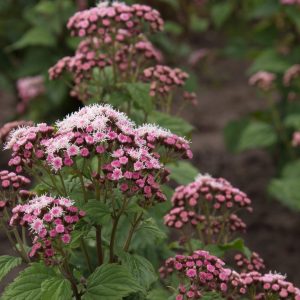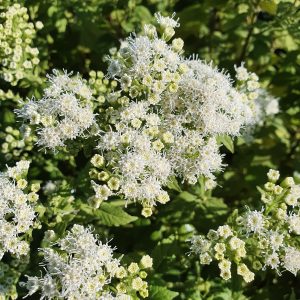Eupatorium, commonly known as Joe-Pye Weed, is a splendid perennial known for its attractive foliage and clusters of fluffy flowers. To ensure the successful growth and flourishing of your Eupatorium plants, follow this comprehensive planting guide:
Site Selection
Sunlight Requirements: Plant Eupatorium in a location that receives full to partial sunlight. These plants generally thrive in at least 6 hours of direct sunlight per day.
Soil Conditions: Choose well-draining soil with a slightly acidic to neutral pH (6.0-7.0). Eupatorium adapts well to various soil types but prefers moist, fertile conditions.
Planting Time
Optimal Timing: Plant Eupatorium in the spring or Autumn when the soil is workable and temperatures are mild. This allows the plants to establish well before extreme weather conditions.
Planting Process
Prepare the Soil: Work the soil to a depth of 12 inches, incorporating organic matter for improved fertility. Ensure good drainage to prevent waterlogging.
Planting Depth: Dig a hole slightly larger than the root ball. Place the plant in the hole at the same depth it was growing in the nursery container.
Spacing: Space Eupatorium plants according to their mature size, typically 18 to 36 inches apart, to allow for proper air circulation.
Watering
Establishment Period: Water the plants thoroughly after planting to help them settle into their new environment. During the first growing season, provide regular watering to promote root establishment.
Mulching
Mulch Application: Apply a layer of organic mulch around the base of the plants to retain soil moisture, regulate temperature, and suppress weeds. Maintain a 2-3 inch layer of mulch but avoid direct contact with the plant stems.
Fertilisation
Moderate Feeding: Eupatorium is adaptable to various soil conditions but benefits from a balanced, slow-release fertiliser applied in spring. Follow package instructions for the recommended dosage.
Support
Staking: Tall varieties of Eupatorium may require staking to provide support, especially in windy locations. Install stakes at planting time or as needed.
Pruning
Deadheading: Remove spent flower heads to encourage prolonged blooming and prevent self-seeding. In late Autumn or early spring, cut back the stems to about 12-18 inches above ground level for a tidy appearance.
Pest and Disease Management
Aphid Control: Keep an eye out for aphids, especially on new growth. Use insecticidal soap or a strong stream of water to control infestations.
Powdery Mildew Prevention: Ensure good air circulation around the plants to minimise the risk of powdery mildew. In case of infection, use appropriate fungicides.
Winter Care
Minimal Winter Care: Eupatorium is generally hardy and requires minimal winter care. A layer of mulch around the base can provide protection to the roots during colder months.
Monitoring and Adjustment
Visual Inspection: Regularly inspect your Eupatorium for any signs of stress, pests, or diseases. Adjust watering and care practices based on your observations.
By following this planting guide, you’ll establish healthy and thriving Eupatorium plants in your garden. Adapt care practices based on your specific growing conditions and enjoy the majestic beauty these perennials bring to your landscape.








